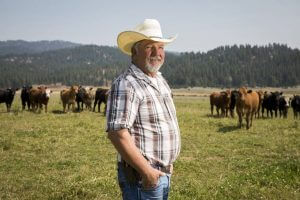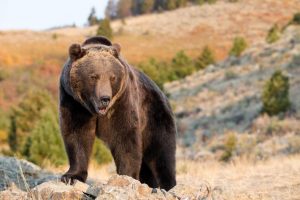
Protect The Wolves™ actually spoke with Cascade Idaho Rancher Phil Davis in this article early in when Ian Whalan the Inventor of Foxlights spent the day with Us.
We were in search of Ranch Locations in Idaho to do deterrent monitoring, deployment testing. Davis denied any participation. Ranchers that deny participation should not be allowed any special Treatment! After all these Ranchers chose their profession and area in which they live. Our Wildlife didn’t request that they move in. The Government certainly doesnt help a construction business that looses a bid, or for that matter looses money on a bid.
Three cows and a calf were lying dead in the irrigated pastures of Phil Davis’ Cascade ranch over a one-week stretch this month.
Davis immediately suspected wolves were to blame, though none of the carcasses had been eaten. He said it was only when the animals’ hides were peeled back that evidence of wolf bites became visible: clots of blood and deep bruising on the muscle.
While the wounds themselves might not have been fatal on their own, Davis said his cattle perished from a lethal mix of their injuries and the stress of being chased by wolves.
“There’s no question about it,” Davis said.
Wolf traps are now on his property and waiting to spring, thanks to Wildlife Services, the controversial federal agency that kills millions of animals across the U.S. each year, often on behalf of the livestock industry.
Davis is hardly alone. According to Idaho ranching associations, 2018 is on pace to break records for wolf attacks on livestock. So far, there have been at least 88 confirmed cases, according to Wildlife Services. That’s up 39 percent from the previous year.
Environmentalist groups and a former Wildlife Services wolf biologist aren’t convinced wolves are attacking more livestock than usual. Instead, they say Wildlife Services and local ranchers are increasingly citing dubious stress-related causes of death — hours or even days after an alleged wolf attack. They say it’s also unlikely wolves are risking their lives trying to run down fully grown cows and not sticking around to feed on them when they die.
Critics say it’s all part of an effort to inflate the numbers of livestock attacks to boost the odds of Wildlife Services securing funding from the Idaho Legislature for its wolf-management program. Davis and others fiercely dispute the allegation.
Gov. Butch Otter had urged the Legislature this year to make funding permanent for the Idaho Wolf Depredation Control Board. Since its formation in 2014, the board has sent more than $1.2 million in Idaho taxpayer dollars to Wildlife Services to respond to wolf attacks on livestock. This session, lawmakers only extended funding for another year. It will need to be voted on again next year.
“We fear this is going to be used as a justification for killing more wolves and extending the funding for Wildlife Services,” said Talasi Brooks, an Idaho-based attorney for Advocates for the West. “It’s only half the story being told.”
Former Wildlife Services employee has doubts
Wildlife Services declined to make an official in Idaho available for an interview. In response to emailed questions, spokeswoman Tanya Espinosa said that in the last few years, Wildlife Services has noticed that some wolves are attacking but not feeding on the livestock they’ve killed, though it’s obvious from the wounds the victim had been bitten.
“Because of this behavior, we recommend producers inform Wildlife Services of the death of any livestock so that a necropsy can be performed even if obvious signs of wolf predation are not present,” she said in an email. “Depredation is confirmed in those cases where there is reasonable physical evidence that an animal was actually attacked and/or killed by a wolf.”
“Depredation” is the word biologists use to describe an animal killing livestock. A “necropsy” is an animal autopsy.
Davis, the Cascade rancher, said he suspects the reason why the predators aren’t eating the carcasses is some wolves are harassing the cattle to train their pups to hunt.
Carter Niemeyer is skeptical.
Niemeyer is a biologist who spent a decade as a wolf management specialist for Wildlife Services. He helped bring the first pack of 15 wolves back into the state in the 1990s. The state estimates there are as many as 90 packs today.
During his time with Wildlife Services, Niemeyer personally killed 14 wolves, shooting 13 them out of airplanes. He’s investigated dozens of suspected wolf attacks on livestock over the years.
He said subcutaneous wounds in cattle can be caused by all sorts of trauma other than from the jaws of wolves. To really know for sure, he said a biologist would need to rule out everything from coyotes to dogs, to diseases, to getting hit by a car, to slamming hard into a fence post. As for stress being fatal, he said only lab tests could determine whether a cow actually died from it. The sort of in-the-field carcass examinations Wildlife Services typically performs would only be a guess, he said.
It’s also rare, he said, for wolves to attack a fully grown cow weighing as much as 1,500 pounds if smaller, less dangerous prey such as their calves are around. And, if they went to all that effort, they’d almost certainly feed, he said.
“Most wolf scientists,” he said in an email, “would challenge the idea that wolves spend a lot of unnecessary time, effort and risk running down large prey with no intention of killing and eating it.”
He said he suspects what’s really going on is the Idaho ranching community’s long-standing animosity toward wolves is leading to predetermined conclusions.
“People like to take the short cut … When an animal dies: ‘Wolves did it,’” Niemeyer said. “It’s been the joke (among wolf biologists) in Idaho. You hear, ‘What else would it be?’ ”
Idaho wolf advocates have asked Wildlife Services to provide evidence showing how it came to its conclusions in its recent livestock death investigations, but so far they say they’ve been stonewalled.
Late last month, Boise-based attorneys at the Western Watersheds Project sued the agency in federal court to force it to provide records it sought under the U.S. Freedom of Information Act.
The case is pending. Wildlife Services hasn’t filed a written response to the allegations.
Espinosa said her agency doesn’t discuss ongoing litigation.
Wildlife Services under fire
Wildlife Services’ eye-popping body count, its controversial methods and its secretive nature have long been criticized by environmentalist groups. They say the federal agency’s methods are outdated, unnecessary, cruel and not backed by science — charges the agency denies.
Occasionally, its tactics have proven dangerous to people and pets.
Last year, a Pocatello teenager triggered a Wildlife Services cyanide coyote trap set on public land near his home. It sickened him and killed his dog. His parents sued the agency in federal court this summer.
“Families shouldn’t have to go through that,” the boys’ mother, Theresa Mansfield, said in an interview with McClatchy. The agency stopped using the traps in Idaho, but still deploys them in some other states.
In Idaho alone, Wildlife Services killed 691,895 animals between 2015 and 2017, including 195 wolves, 10,470 coyotes and 16 cougars, according to a McClatchy analysis.
Wildlife Services enjoys broad support in this state from influential sheep and cattle associations, Gov. Otter’s administration and Republican representatives in Congress who say its work keeping predators in check is vital to the state’s rural ranching economy.
“For those of us who deal with lots of predators, Wildlife Services is essential to our business,” said Harry Soulen, a sheep rancher based in Weiser.
In an email, Espinosa said Wildlife Services doesn’t perform wildlife management services on its own accord and will use nonlethal control methods if it can. She said Wildlife Services only takes action when called upon, and only with the blessing of state or federal wildlife authorities.
But critics say Wildlife Services operates on an outdated philosophy that harkens back to its founding in the Great Depression as the wildlife extermination wing of the U.S. Department of Agriculture.
“Predator control is just putting a Band-Aid on a gushing wound. It’s not really going to work,” said Brooks, the Advocates for the West attorney. “It’s harmful to wildlife species, and it’s cruel, and it’s not something that I think that the public is all that willing to accept in the 2000s.”
Wildlife Services’ critics scored a major victory in June. A federal judge in Idaho slammed the agency’s scientific rationale behind proposals it floated to kill or remove Idaho predators such as coyotes and ravens, to increase numbers of wild animals including deer, bighorn sheep, grouse and endangered ground squirrels. Wolves weren’t included in those plans.
Responding to a suit filed by environmental groups, Chief U.S. District Court Judge B. Lynn Winmill blasted the agency for disregarding concerns raised by officials at other government agencies tasked with protecting wildlife. Winmill said federal and state biologists cited studies that killing predators wasn’t effective and had negative consequences on the ecosystem.
“It is rare,” Winmill wrote, “to encounter such an unanimity of critical comments from other agencies.”
Winmill said he was inclined to order Wildlife Services to perform a new environmental review, but he delayed taking action at the request of the parties in the case.
While the ruling didn’t affect Wildlife Services’ wolf management program, ranchers such as Davis in Cascade are troubled by its implications.
He fears that Wildlife Services will someday be hamstrung from doing a job he sees as vital to protecting his and other ranchers’ livestock from wolves. Davis is convinced they have been harrying his stock to death and leaving their carcasses to rot.
“They’re the only defense we have (to prevent) unlimited killing of livestock,” Davis said.
Source: Is Wildlife Services inflating Idaho wolf livestock kills? | The Sacramento Bee
Cut Off USDA Wildlife Services Funding, Endangered Species List, Oppose Welfare Ranching not Wolves, Protect The Wolves Ban Grazing Allotments, Oppose Welfare Ranching, Protect The Wolves



















